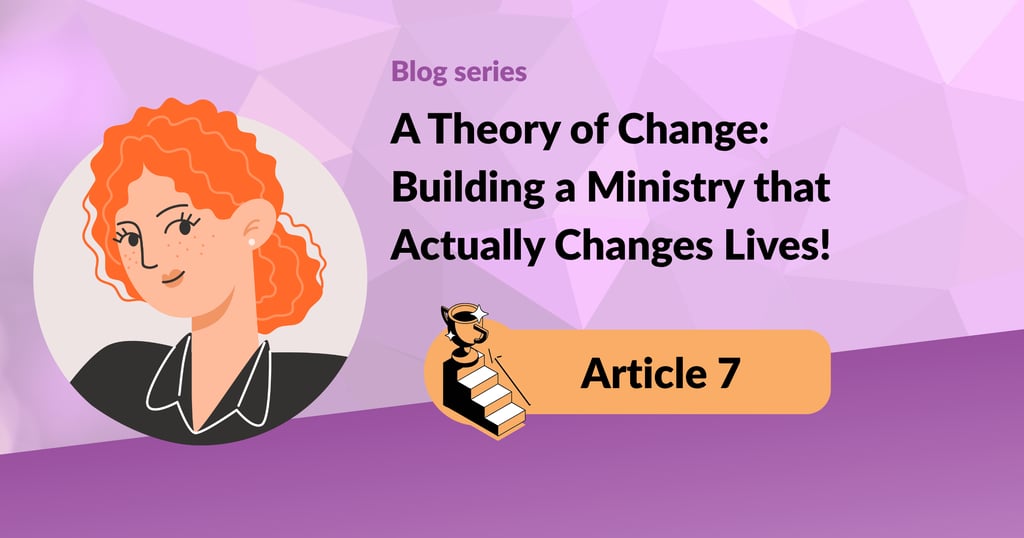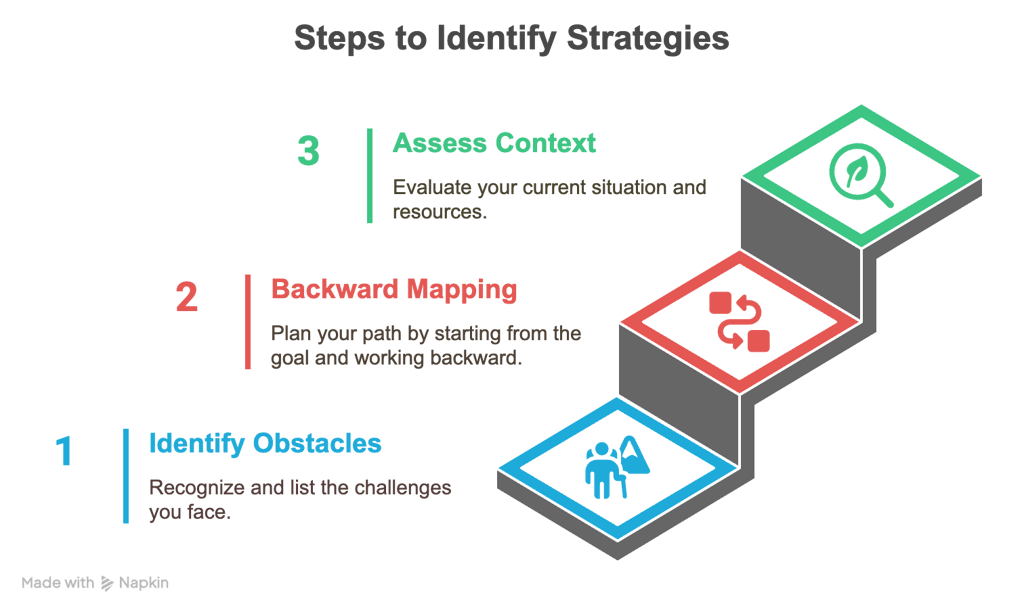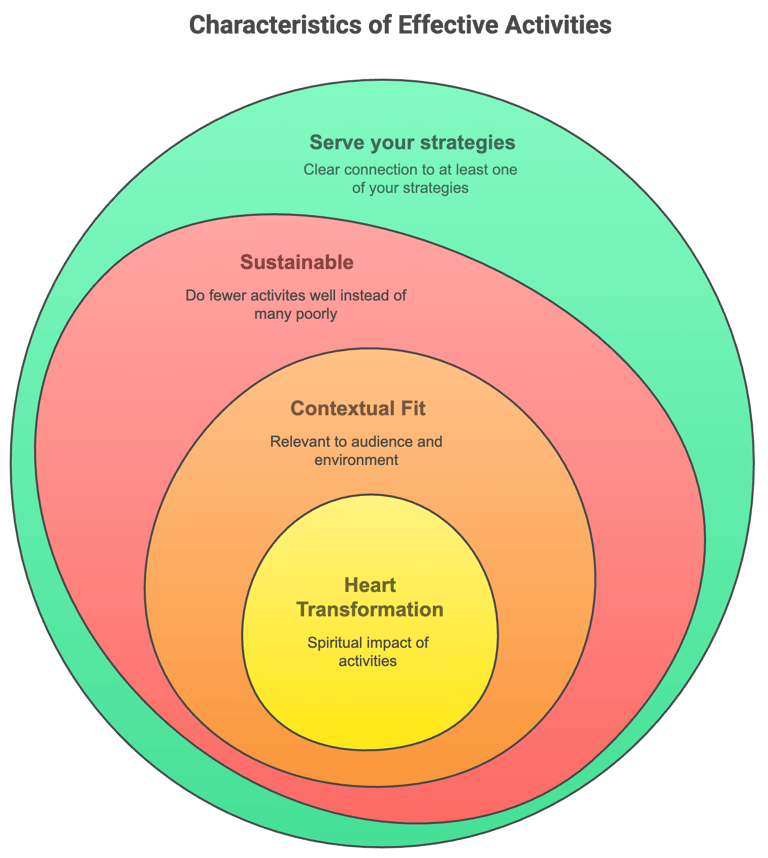7. Creating a Theory of Change Steps 2 & 3: Determining Strategies and Activities
Brandon Booth
7/14/20256 min read
Never miss a post! Signup for my email updates today and get expert guidance delivered directly to your inbox!
Last week we tackled Step 1: identifying the real problem your ministry exists to solve and the specific change you want to create. Now you have a clear goal and understand the obstacles preventing that change. But you're probably asking: "What do I actually DO about it?"
Today we'll determine your specific strategies and the activities that will implement them. Using proven Theory of Change methodology, we'll learn how to move from knowing what you want to achieve to having a concrete plan for achieving it. This is where your ministry's unique context and calling really matter—your strategies will be different from every other ministry. Let's start by understanding what strategies actually are.
Understanding Strategies and Activities
What Are Strategies?
Your strategies are your chosen approaches for addressing the obstacles that prevent your goal. Think of them as your game plan—the specific ways you'll tackle the barriers standing between where people are now and where you want them to be.
Key insight: Strategies remain relevant even if you shift specific tactics or activities. They're your overarching approach, not the individual actions you take.
Example: "Build supportive community" is a strategy that could include various activities like support groups, mentoring, or retreats. The strategy stays the same even if you change which specific activities you use to implement it.
What Are Activities?
Activities are the concrete things you do—the programs, events, services, and interactions you implement in order to execute your strategies. If strategies are your "what," activities are your "how."
Key insight: Activities are the "how" of your strategies—the specific ways you implement your chosen approach. They're the visible, tangible expressions of your strategic thinking.
Example: If your strategy is "build supportive community," activities might include weekly support groups, monthly social events, and one-on-one mentoring relationships. Each activity serves the same strategy but in different ways.
The Relationship Between Strategies and Activities:
Strategies are the bridge between your goal and your activities. They connect your big-picture vision to your day-to-day actions.
Activities without strategies lead to random busyness. You end up doing lots of things without a clear sense of how they connect to your ultimate goal.
Strategies without activities remain abstract and unimplemented. You have great ideas but no concrete way to bring them to life.
Multiple activities can serve the same strategy, and one activity might serve multiple strategies.
Identifying Your Strategies
Start with Your Obstacles (from Step 1):
Review the barriers you identified that prevent your goal. These obstacles are your roadmap to effective strategies.
Ask for each obstacle: "What approach would address this specific barrier?" Don't try to address every obstacle with one strategy—different barriers require different approaches.
Example: If shame prevents people from seeking help, you need a strategy that creates safety and acceptance. If lack of community support is an obstacle, you need a strategy that builds relationships and connection.


Use Backward Mapping:
Start with your goal and work backward. This ensures your strategies actually connect to the change you want to create.
Ask: "What would need to be true for people to experience this transformation?" Then work backward from there.
Then ask: "What approach would create those conditions?" Keep digging deeper.
Keep asking "what would need to happen before that?" until you reach actionable strategies you can actually implement.
For example: Goal = "Help teenagers develop secure identity in God's love"
What needs to be true? They need to experience God's personal love for them
What would create that? Safe relationships where they can be vulnerable and accepted
What would create that? Consistent adult mentors who demonstrate God's heart
Strategy: "Develop authentic mentoring relationships"
Consider Your Context and Capacity:
What are you uniquely positioned to do? Consider your skills, relationships, and resources. Build on your strengths rather than trying to do everything.
What does your community respond to? Urban vs. rural, different cultures, different age groups—all of these affect which strategies will be most effective.
What partnerships are available? Some strategies might require collaboration with other organizations, churches, or community groups.
What have you seen work in similar contexts? Learn from others while avoiding the trap of just copying what worked somewhere else.
Connect to Heart-Change Principles:
Remember the 4 key strategies from Article 3 as guidance: facilitating encounters with God, using Gospel-Law-Gospel sequence, employing technologies of the heart, and reframing spiritual practices as faith practices.
Ask: "How will this strategy facilitate encounters with God?"
Ask: "How will this create safety for people to address areas needing change?"
Ask: "How will this engage hearts, not just try to modify behavior?"
Examples of Ministry-Specific Strategies:
Recovery Ministry: "Provide peer mentoring," "Create shame-free community," "Offer family healing support"
Youth Ministry: "Develop authentic adult relationships," "Create identity-affirming experiences," "Build leadership opportunities"
Marriage Ministry: "Facilitate couple retreats," "Provide ongoing support groups," "Offer crisis intervention"
Notice how each strategy is specific to the ministry context while still connecting to heart-change principles.
Testing Your Strategies:
The Obstacle Test: Does this strategy directly address one of your key obstacles? If not, it might be a nice idea but not essential to your theory of change.
The Specificity Test: Is it specific enough that someone else could understand and implement it? "Help people" is too vague. "Provide peer mentoring" is specific.
The Capacity Test: Do you have the resources and skills to implement this well? Be honest about what you can actually accomplish.
The Heart Test: Does this strategy create space for heart transformation, not just behavior change? This is what makes your approach distinctively Christian.
Developing Your Activities
Activities Flow from Strategies:
For each strategy, brainstorm specific activities that would implement that approach. Don't start with activities and try to fit them into strategies afterward.
Ask: "What concrete actions would bring this strategy to life?" Think about the actual programs, events, and interactions you would create.
Consider different types of activities: programs, events, services, one-on-one interactions, online resources. Variety helps you reach different people in different ways.
Characteristics of Effective Activities:
Directly serve your strategies (not just things you think would be "nice to do"). Every activity should have a clear connection to at least one of your strategies.
Are sustainable with your current resources. It's better to do fewer activities well than to overcommit and do many activities poorly.
Fit your context and the people you're trying to reach. Consider practical factors like location, timing, cultural appropriateness, and accessibility.
Create opportunities for the heart transformation your goal describes. Even practical activities can have the potential for spiritual impact.


Examples of Strategy-Activity Connections:
Strategy: "Build supportive community for recovery"
Activities: Weekly recovery support groups, monthly family events, quarterly retreats, one-on-one mentoring program
Strategy: "Develop authentic adult relationships" (youth ministry)
Activities: Mentoring program, small group discipleship, service projects, informal hangout times
Strategy: "Create shame-free environment" (various ministries)
Activities: Training volunteers in Gospel-Law-Gospel approach, creating welcoming physical spaces, sharing stories of transformation
Notice how multiple activities can serve the same strategy, and how each activity is concrete and specific.
Your Next Step
Exercise 1: The Obstacle-Strategy Map
List your key obstacles from Step 1
For each obstacle, brainstorm 2-3 potential strategies that could address it
Ask: "What approach would overcome this barrier?"
Exercise 2: The Strategy-Activity Brainstorm
For each strategy you identify, list 5-10 possible activities
Don't edit yet—just brainstorm
Then narrow down to the 2-3 activities you could implement well
Exercise 3: The Resource Reality Check
For each activity you're considering, honestly assess:
Do we have the skills to do this well?
Do we have the time and people?
Do we have the financial resources?
Can we sustain this long-term?
Exercise 4: Create a Strategy-Activity Map
Strategy 1: [Your approach]
Activity A: [Specific action]
Activity B: [Specific action]
Strategy 2: [Your approach]
Activity A: [Specific action]
Activity B: [Specific action]
Take time to work through these exercises carefully. The clarity you gain here will make the next steps much easier.
What's Next
Having clear strategies and activities is crucial, but there's still a missing piece: how do you know if your strategies are actually moving you toward your goal?
Next week, I'll show you Step 4: how to identify outcomes that link your strategies to your goals using "so-that" thinking—the bridge that connects what you do to the change you want to create. This is where many ministries get stuck, but it's also where the real breakthrough happens.
Struggling to identify the right strategies and activities for your ministry? I'd love to help you think through approaches that will effectively address your specific obstacles. Every ministry context is unique, and sometimes it helps to have someone ask the right questions and help you see connections you might miss. Schedule a free 30-minute conversation with me, and let's work together to develop strategies that will actually move you toward your goal.
-------------------
This is the seventh article in our series "A Theory of Change: Building a Ministry that Actually Changes Lives!" ← See the previous article, or check out the next article here →


Let's build!
Connect with me today and let's start building your ministry that will change lives!
© Brandon Booth, 2025
Expert guidance for nonprofits and ministries.
Brandon Booth



